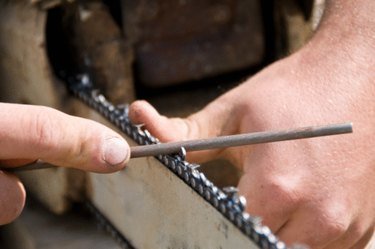
When sharpening a chain saw, the proper angle and depth of the file must be gauged correctly. Improper sharpening will lead to uneven cutting teeth, which will cause a wide assortment of cutting problems, such as pulling to the left or right. Uneven teeth will cause dangerous situations for the sawyer and make his job more difficult. Each chain, however, will have its own angles for sharpening.
Filing Angle
Video of the Day
Save the package that your chain came in. This package contains all of the crucial sharpening information necessary, such as filing angle. The filing angle is the angle of the top plate, when looking down on the teeth, to the bar. This angle often is marked on newer chains with a small line that runs across the top of the tooth. This indentation is an angle guide for hand filing. If this mark isn't present on the teeth, start filing at a 30-degree angle and gradually increase up to 40 degrees if the chain doesn't meet your cutting needs.
Video of the Day
Filing Depth
The hook of the tooth, under the top plate, has its own angle, or depth setting. This depth will mark off the length of a chip the chain bites out of the wood during each pass. This depth should be set according to your cutting needs. Larger, thicker and denser wood will need a deeper depth. Thinner, lighter and smaller wood will require a more shallow depth. Getting this depth correctly will take lots of sharpening practice. Use a depth gauge tool to help approximate the depth needed for the chain.
Filing Rakers
The flat stubs in front of the cutting teeth usually are referred to as the depth gauges, or rakers, because they rake across the wood, scoring it before the teeth scoop it out. These rakers set the thickness of the wood chip. They must be filed flat and parallel to the bar. Don't file at a down sloping angle, hold your hand steady when you push the file across the raker. Take the rakers down after 3 to 5 sharpenings on the chain, using a crosscut flat file. Place one of the chain's depth gauges into the slot on the tool and file any portion that extends out of the slot flush with the top of the tool.
Filing Tips
Getting the teeth and rakers filed evenly is the biggest challenge to sharpening a chain. If these angles are off, the chain will not cut at full performance. Keep track of the number of file strokes you use and apply it to every tooth, even if it's still a little dull or chipped. If you notice one or two teeth are smaller than the rest, you will need to file all of the teeth down to that size, which can be a time-consuming project. It's better to sharpen the chain regularly, so you only need 3 to 4 swipes of the file.